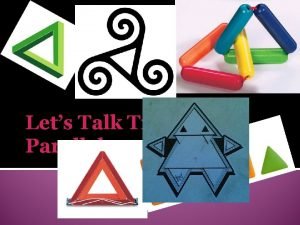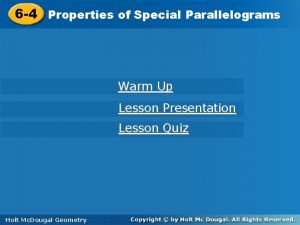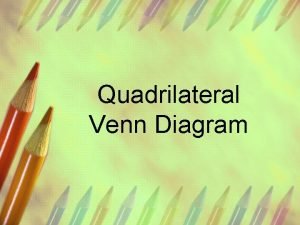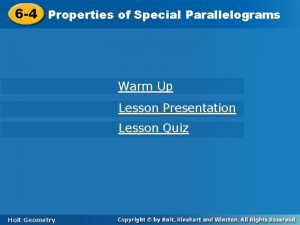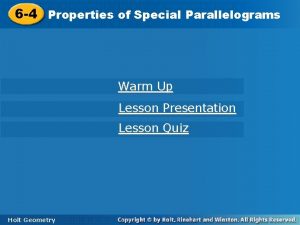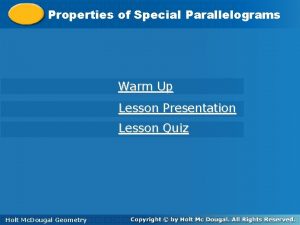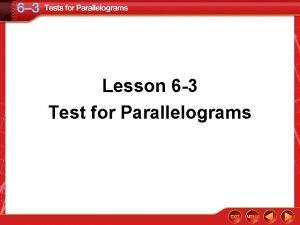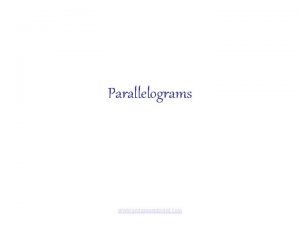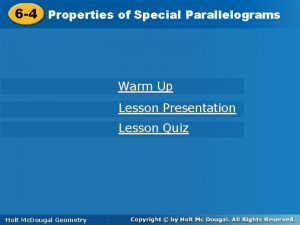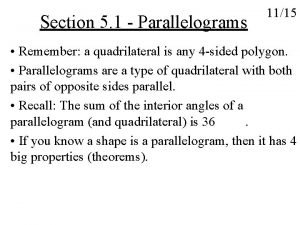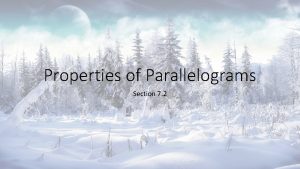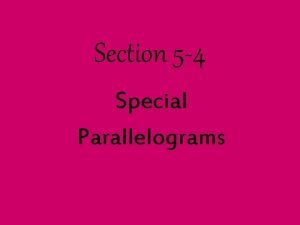Section 6 2 Parallelograms EQ What are the














- Slides: 14

Section 6. 2: Parallelograms EQ: What are the properties of parallelograms?

Vocab! Parallelogram Opposite Sides Theorem Parallelogram Opposite Angles Theorem A quadrilateral with both pairs of opposite sides parallel J K L M If JKLM is a parallelogram, then ∠J ≅ ∠L and ∠M ≅ ∠K J M K L

Example 1 In parallelogram ABCD, suppose m∠B = 32 , CD = 80 inches, and BC = 15 inches. a) Find AD AD = BC AD = 15 b) Find m∠C 32 + 32 = 64 360 – 64 = 296/2 = 148° c) Find m∠D = m∠B m∠D = 32°

Example 2 Find the values of x and y.

You Try! 1. Find FG and the measure of angle G. m∠E = m∠G = 60° 2. Find the values of x and y.

Consecutive interior angles theorem… x + y = 180°

Vocab! Parallelogram Consecutive If JKLM is a parallelogram, then x + y = 180° Angles Theorem J K y x M Parallelogram Diagonals Theorem y x L If ABCD is a parallelogram then AP = PC and DP = PB A B P D C

Example 2 a) Find AB AB = DC AB = 30 b) m∠C = m∠A m∠C = 36° c) m∠D 180 – 36 = 144°

Example 3 If WXYZ is a parallelogram… a) Find the value of r. WX = ZY 4 r = 18 r = 4. 5 b) Find the value of s. 7 s + 3 = 8 s s = 3 c) Find the value of t. Alternate Interior Angles 2 t = 18 t = 9

You Try! Find the indicated measure in parallelogram LMNQ. Explain your reasoning. 1. LM LM = QN 13 2. LP = NP 7 3. LQ LQ = MN 8 4. MQ MP = QP QP = 8. 2 QP + MP = MQ 16. 4

You Try Cont. • 180 – 100 = ∠LMN m∠LMN = 80° m∠NQL = m∠LMN 80° m∠MNQ = m∠MLQ 100° Alternate interior angles m∠LMQ = m∠NQM 29°

Coordinate Geometry Using a coordinate grid to prove certain relationships about polygons. Using coordinate geometry, how can you prove a shape is a parallelogram? Use theorems to prove the shape is a parallelogram.

Example 4 a) What are the coordinates of the intersection of the diagonals of parallelogram MNPR, with vertices M(– 3, 0), N(– 1, 3), P(5, 4) and R(3, 1)? P N R M

Example 4 cont. b) What are the coordinates of the intersection of the diagonals of parallelogram LMNO, with vertices L(0, – 3), M(– 2, 1), N(1, 5) and O(3, 1)? N M O L
 Antigentest åre
Antigentest åre Khi nào hổ con có thể sống độc lập
Khi nào hổ con có thể sống độc lập điện thế nghỉ
điện thế nghỉ Các châu lục và đại dương trên thế giới
Các châu lục và đại dương trên thế giới Các loại đột biến cấu trúc nhiễm sắc thể
Các loại đột biến cấu trúc nhiễm sắc thể Nguyên nhân của sự mỏi cơ sinh 8
Nguyên nhân của sự mỏi cơ sinh 8 Bổ thể
Bổ thể Phản ứng thế ankan
Phản ứng thế ankan Làm thế nào để 102-1=99
Làm thế nào để 102-1=99 Thiếu nhi thế giới liên hoan
Thiếu nhi thế giới liên hoan Fecboak
Fecboak Chúa sống lại
Chúa sống lại Một số thể thơ truyền thống
Một số thể thơ truyền thống Sơ đồ cơ thể người
Sơ đồ cơ thể người Công thức tính thế năng
Công thức tính thế năng















